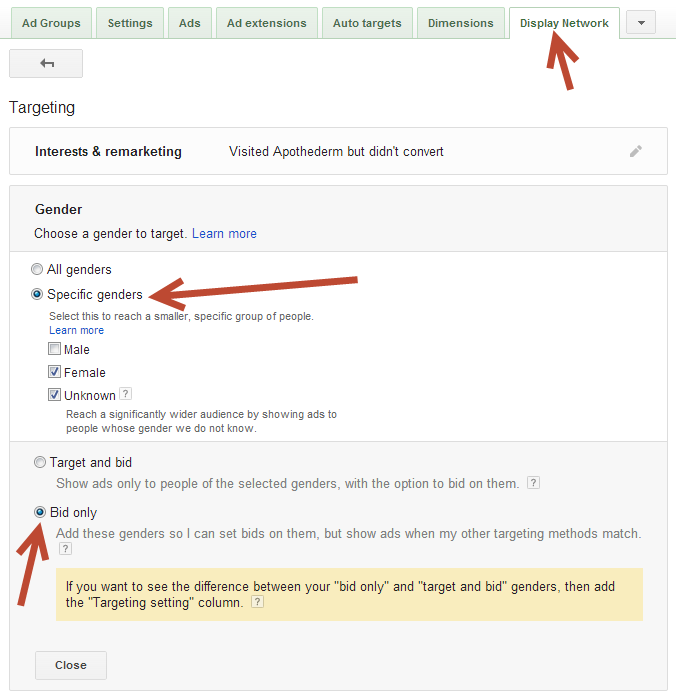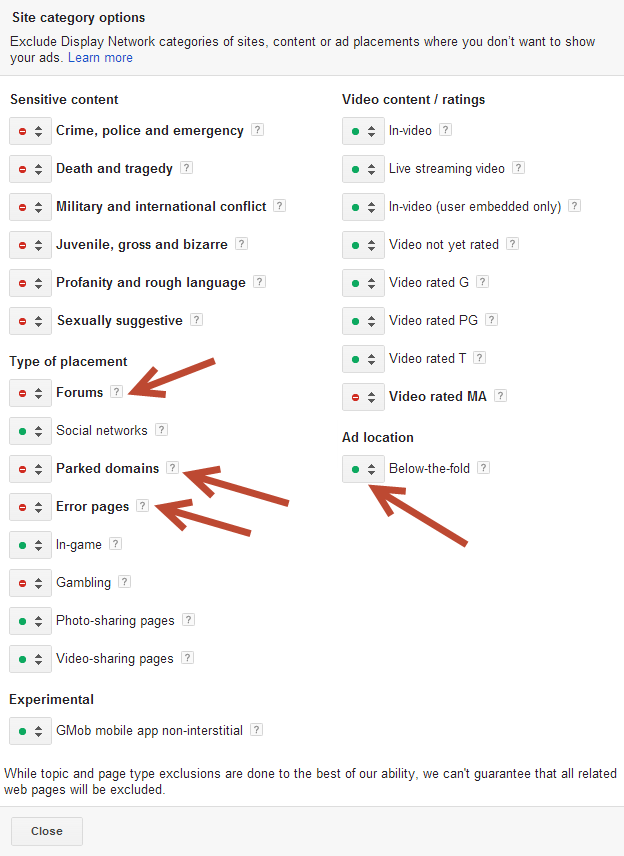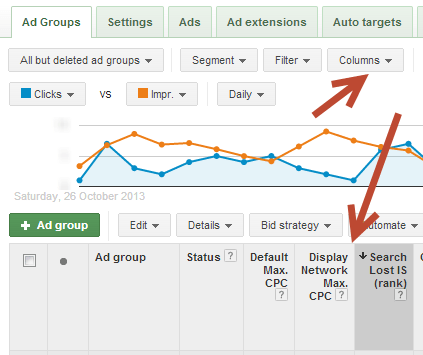Since AdWords (now Google Ads) remarketing launched back in 2010, it has gone from strength to strength with new features and functionalities, from building lists with Google Analytics to Dynamic Remarketing. These ever-improving functionalities have made it even more important for advertisers to be creating and optimizing remarketing campaigns with best practices in mind. This post a complete list of best practices and tips to help you get the most out of your Google remarketing campaigns.
You can’t maximize your Google Ads ROI if you don’t know what to optimize. Get a free Google Ads account audit and give yourself a head start!
Before you get started with remarketing…
Consider these tips before you actually start creating your remarketing lists and campaigns.
Manage client expectations by setting clear remarketing objectives
As with all digital marketing projects, you must be sure of your objectives before you dive into remarketing. This will help you manage your client’s expectations (or your boss’s) and ensure everyone is singing from the same hymn sheet! For example, your client might only have ever used standard PPC, and expect remarketing to provide the same kind of results.
Ensure your client is aware that remarketing won’t achieve a ton of one-per-click conversions and isn’t likely to deliver large levels of traffic in the same way that your PPC ads might do. Let them know that remarketing will help to reinforce their brand to users who have already visited their site, and is great at influencing conversions, even though it’s often not the last direct interaction the user has before making a purchase.
Remarketing strategy
A big chunk of the time you have for setting up the remarketing project should be spent planning your remarketing strategy and the lists you are going to build.
Whether remarketing works for your business will depend on the lists you create and how you use them – so don’t rush this.
Your objectives for the project will help determine which lists you’ll create, but you might find some of the examples listed here helpful.
Update your Privacy Policy
Before you add the remarketing code to your website and start building lists, it is best practice to update your Privacy Policy, so that it declares your use of the DoubleClick cookie. You could add something like this to the policy:
“DoubleClick: We use Google Analytics remarketing codes to log when users view specific pages or take specific actions on a website. This allows us to provide targeted advertising in the future. If you do not wish to receive this type of advertising from us in the future you can opt out using the DoubleClick opt-out page or the Network Advertising Initiative opt-out page.”
You might also want to check Google’s Privacy Policy guidelines to ensure your Privacy Policy is up to standard for using other AdWords products.
Best Practices for Setting up Remarketing in AdWords/Google Ads
Putting the remarketing code on your website
There are two sets of code available for setting up remarketing: Google Analytics remarketing code and AdWords remarketing code.
I would recommend using the Google Analytics remarketing code instead of the AdWords version, as it has the additional benefit of allowing you to use visitor behavior within list criteria. For example, you could create a list to target users in a certain geographical location who stayed on the site for at least 3 minutes using the Google Analytics code. The AdWords code only allows lists to be built based on pages viewed on your site.
If you are planning on using Dynamic Remarketing, you’re required to use the AdWords remarketing code. If you’d prefer to run standard remarketing using the Google Analytics code, you can always use both sets of code on the site to allow for dynamic and standard remarketing. AdWords has advised me that the codes do not conflict. The only limitation of having both sets of code on your site simultaneously is that you may find visitors are placed on multiple lists, and served ads from multiple campaigns. This should be considered when setting your frequency capping, as using both sets of code means users are even more likely to appear on multiple lists.
List membership duration
It’s tempting to choose the maximum list membership duration of 540 days so you can have flexibility for the ways you use the list later down the line. However it’s worth remembering that most ordinary internet users won’t be aware of how to clear their cookies, and so you really will be following them around for the full list duration unless they convert. No one wants to be that annoying stalker-brand that takes it too far, so it’s best practice to only set membership durations for as long as they are actually required. (Savvy consumers can opt out of seeing your ads entirely by clicking the “AdChoices” icon and adjusting their settings.)
Set your list durations dependant on what you want to achieve:
- If you’re targeting people for an annual purchase (car insurance for example) then go for at least 13 months long.
- A service that requires people to sign up after 30 days (for example if you are offering a 30-day free trial) should have lists with a membership of around 60 days so you know users will be targeted for a reasonable amount of time after the trial to encourage sign-up.
Frequency capping
This is possibly the most fundamental of all remarketing best practices. It’s the difference between lightly reminding audiences about your brand, and stalking them until they hate you.
You can find it in the Settings tab of your campaign, and you can set it at campaign, ad group or ad level. Choose whether to set it on monthly, weekly or daily limits.
When deciding what level to set your frequency capping at, you should consider how many remarketing campaigns you have, or how many ad groups there are within your remarketing campaign, if you only have the one campaign.
Assuming you have multiple campaigns, I’d recommend around two impressions per week, per campaign. This means that if you have five campaigns and a user is a member of at least one list in all the campaigns, the maximum exposure they would receive is 14 impressions per week. This is quite high, but the likelihood is that not all users will be on a list within each campaign, so the average frequency will be less.

Once your campaigns have been running a while and you have significant data, you should review the reach and frequency data within the Dimensions tab. Here you can see how often visitors are served one of your remarketing ads and assess whether you think it’s too often and whether your frequency capping needs adjusting.
Additional targeting for remarketing
Remarketing is a kind of behavioral targeting, which means that the user determines where your ads are show by the content they visit online.
If you have a smaller budget and you want to narrow this down, so you’re only targeting users who are the most likely to convert, you could try using other targeting methods alongside remarketing audiences, for example demographic targeting for age and gender. For example if you were selling beauty products for females only, you could set the gender to target only females. Remember to choose the “Bid only” option, which means you’ll have the option to increase bids for females.
It’s important to be aware that Google’s assumptions about demographics aren’t necessarily correct, so you should also target “Unknown” to avoid missing out on any potential impressions for females. You can set this up within the Display Network tab by clicking the green “+targeting” button in the top left-hand side of the screen.

You can follow the same process for refining your remarketing to target member ages.
Refine your targeting by only remarketing to “quality” visitors
If you’d like to narrow down your remarketing so it only targets users who have had a quality interaction with your site, you could try adding the following criteria to your lists:
- Exclude people who have bounced
- Exclude people who have spent less than ten seconds on the site
To do this, you’ll need to create these lists within Google Analytics and then create custom combination lists within AdWords which exclude them.
Stop your ads showing on “bad” content
There are some content types that you probably won’t want your ads to show on. You can exclude site categories to avoid your ads being shown around content that you don’t want associated with your brand.
Within the Display Network Tab, scroll to the bottom of the page and click the green “+Options” button for campaigns:

You will then see the following page where you can exclude site categories.

I’d also recommend excluding error pages, parked domains and forums as these tend to have poor content that you may not want associated with your brand.
You can also experiment with excluding your ads from showing below the fold of the page to see how this affects performance. You should be aware that you may have to bid higher to ensure your ads are always eligible for above-the-fold placement.
Further refine your remarketing by reviewing your placement report and excluding any placements which aren’t appropriate. Don’t exclude too much though, as remarketing isn’t really about the relevance of the site, as it targets based on the user’s behavior rather than site content.
Structuring remarketing campaigns
In an ideal world, you should have an individual remarketing campaign for each list you are running. If this isn’t possible, try having separate campaigns for each kind of strategy. For example, you could have two different campaigns for ad groups with lists that were created:
- To generate secondary purchases and upsells
- To target users who viewed a particular product category but didn’t convert
If these structures aren’t possible, you should at least ensure each strategy has its own ad group in one dedicated remarketing campaign. As you gain enough data to assess their performance, you should split the top performing lists into their own campaigns so that you can allocate specific daily budgets to them.
Remarketing ad creation best practice
A bespoke ad creative for each strategy and list is the ideal scenario, so that you can ensure the ad creative is as relevant as possible to the audience you are targeting.
For example, if you are trying to generate repeat purchases, your ad creative could contain a discount code for the consumer’s next transaction. If you are targeting users who viewed a specific product page but didn’t complete a purchase, your ad creative should feature that product.
In addition to ensuring the ad is relevant, the following ideas are also best practice with remarketing display ad creation:
- The ad should have continuity with your website design and include your logo, so that the user is aware it’s an ad for the same website they have already visited.
- Ensure you have a still version of the ad if there is also an animated version, as not all sites support animated ad formats.
- Ensure each creative works across all the different ad sizes, so that you can include one of every ad size in each ad group. Not all sites support all ad formats so this ensures you will have the opportunity to show if you are eligible.
- Include a text ad in each ad group, as some sites won’t support image ads and this ensures you’ll have the opportunity to show. You can always remove the text ad later if it performs poorly.
- You should include a call-to-action button and demonstrate any USPs or offers within the ad creative.
Conversion tracking
Conversion tracking for remarketing is set up in the same way as standard AdWords campaigns; however, you should be aware that if you choose to import goals or e-commerce tracking from Analytics to be tracked as conversions in AdWords, they will not track View-through-conversions.
This is limiting because remarketing tends to contribute to a strong level of View-through-conversions, and there will be no visibility of this if you choose to import goals or e-commerce tracking from Google Analytics to be tracked as AdWords conversions.
Due to this, I’d recommend using standard AdWords conversion tracking code for conversion tracking with remarketing.
Remarketing optimization best practices
Now let’s review some best practices for testing and improving your remarketing performance.
Test your list criteria and custom combinations
Setting up lists isn’t just important at the start of your remarketing project. You should experiment with your lists and combinations as part of your optimization process to see which combinations work best.
For example, you could test:
- Different list member durations (try different messaging for different list durations too – a message that worked a week after they visited your site might not work a month after they have visited it)
- Different gender targeting alongside lists
- Exclude different lists using custom combinations (for example exclude users who bounced, or those who spent less than ten seconds on your site)
- Exclude different categories (parked domains, forums, games and other site categories)
Monitoring lost Impression Share due to rank
Customise your columns at ad group level to see lost Impression Share due to rank. If your ad group is missing out on a significant level of impression share due to rank, you should consider increasing your bids:

Test your landing pages
Try sending the user to different pages on the website. For example if they viewed a more expensive version of a product, try landing them on a lower-cost version of it. If they viewed an item from a particular range of products you stock, try landing them on the main category page rather than back on that same product page. You could even do this using AdWords Experiments to ensure a completely fair test.
Test your ad creative
You can use AdWords experiments to provide a completely even test for your ad creatives. Try testing different colors on your call to action, different wording and different images. As with all split testing, be sure to only make one small change to the new ad so that you can pin-point which changes have a positive (or negative) impact.
Don’t forget normal optimization techniques
Often we get so carried away with optimizations specific to display and remarketing that we forget about all the other techniques that are normally best practice. Here’s a few to get you started:
- Review performance by location and use location bid adjustments if required
- Review performance by time-of-day and use scheduling bid adjustments if required
- Review your performance on mobile devices and amend your mobile bid adjustments
Keep trying new formats
Even if you already use standard remarketing, there’s no reason why you can’t use other formats of remarketing alongside it. For example one of my clients currently uses standard remarketing for one part of their strategy, but also uses Dynamic Remarketing to fulfill another part.
There are four different kinds of AdWords Remarketing at the moment, so why not test them all and see which ones work for your account?:
- Standard AdWords Remarketing
- Remarketing Lists for Search Ads
- Dynamic Remarketing (only for e-commerce websites)–Find out how to set up dynamic remarketing for retail here.
- YouTube Remarketing
This post has hopefully provided you with some guidelines on AdWords remarketing best practices, but don’t forget that we only find the true “best practice” when we discover the most effective ways of doing things. Something that is effective for one account may not be the most effective in another account, so don’t be afraid to keep testing and trying new ideas within your remarketing campaigns. If you have any other best practice ideas for remarketing, please feel free to share them in the comments below.
Tara West is an experienced PPC specialist at Koozai, and has worked on PPC projects in lots of different verticals, ranging from small local businesses to giant e-commerce accounts. When she’s not working on client projects, she is usually organising digital marketing events, speaking at conferences or writing for the Koozai blog.







